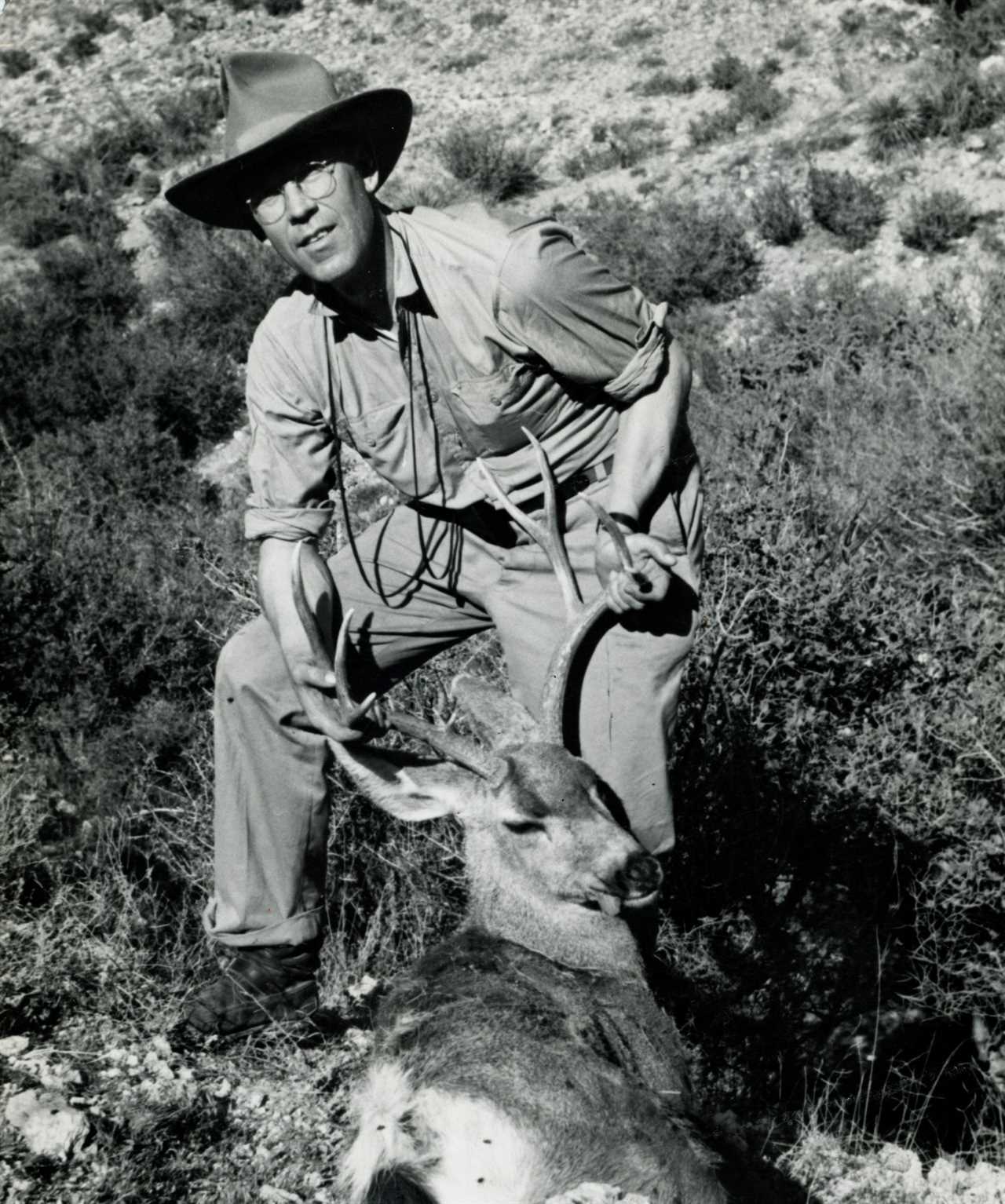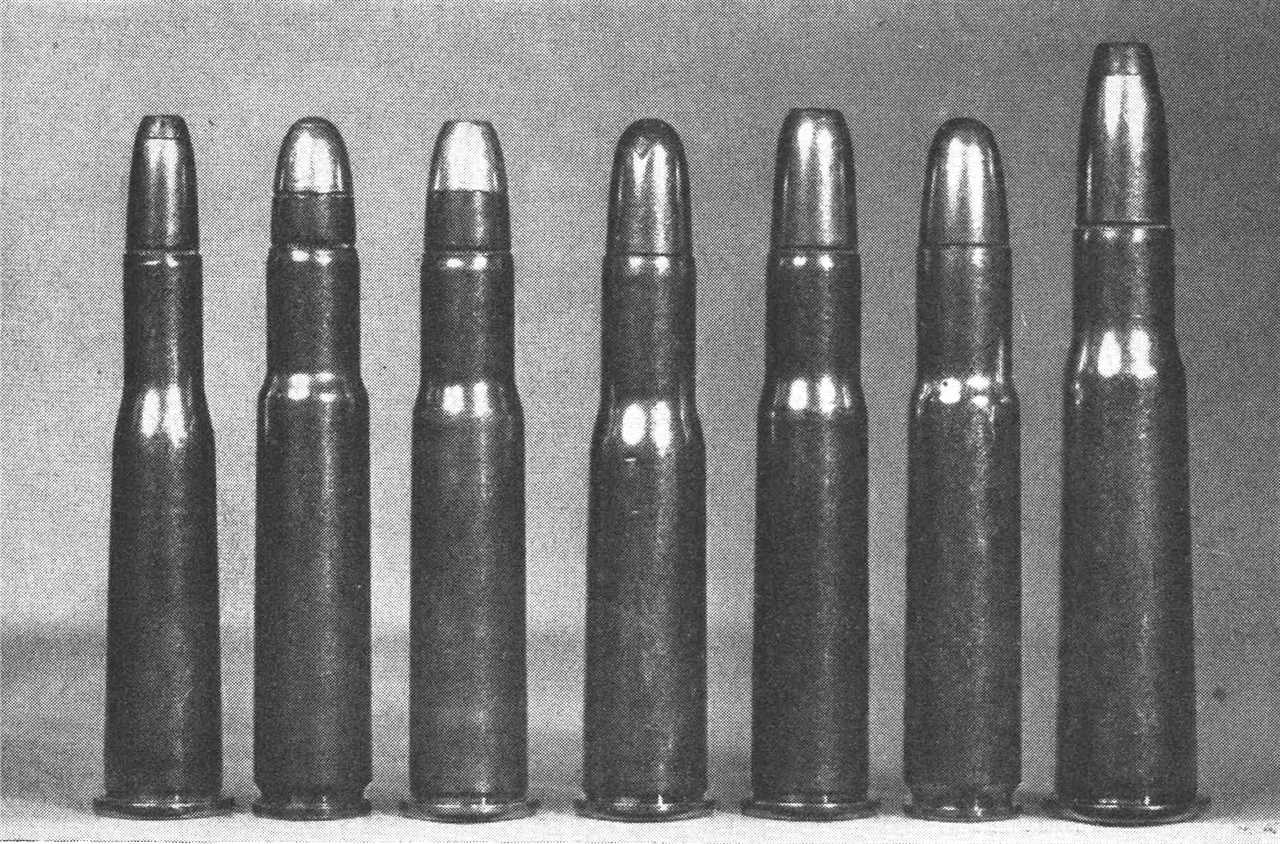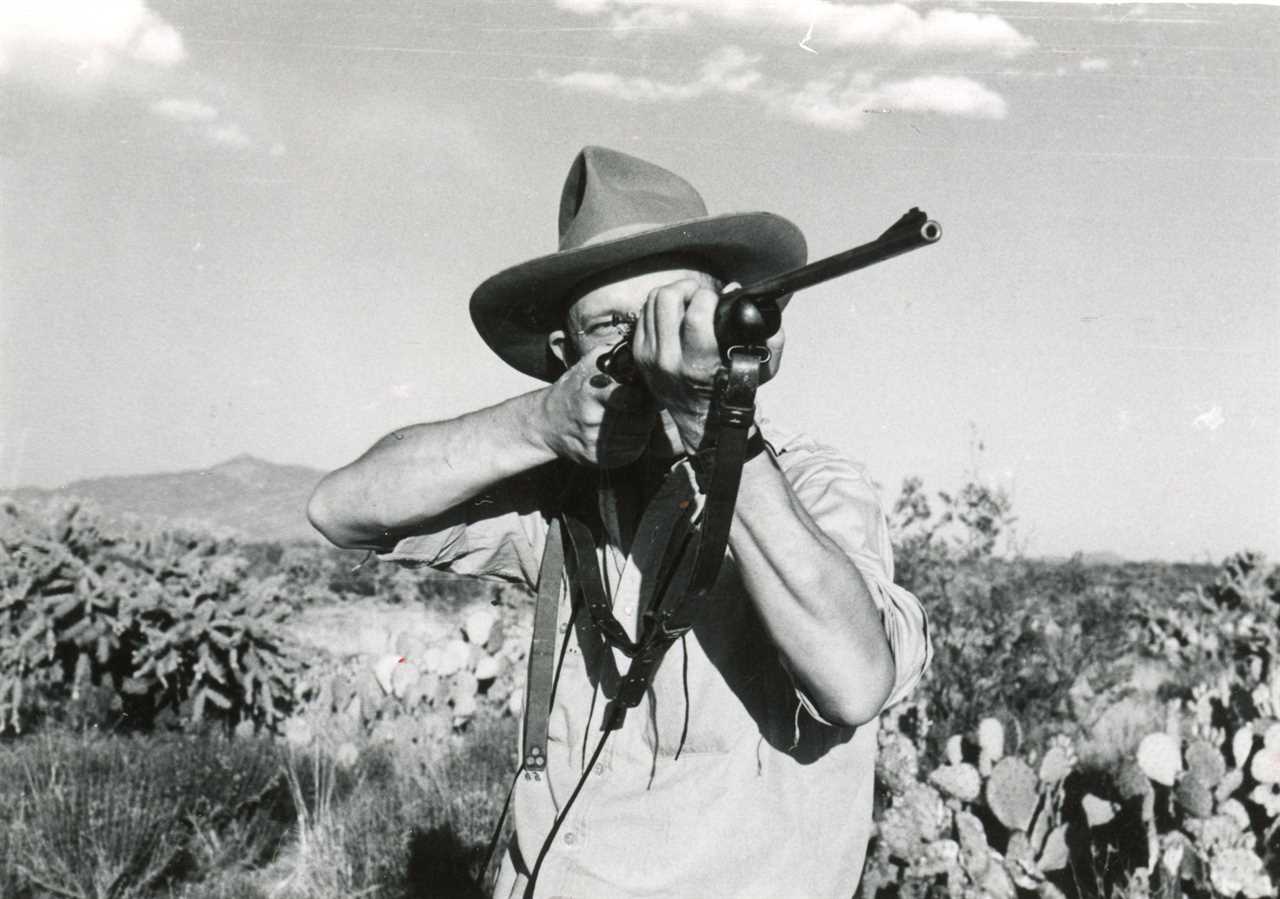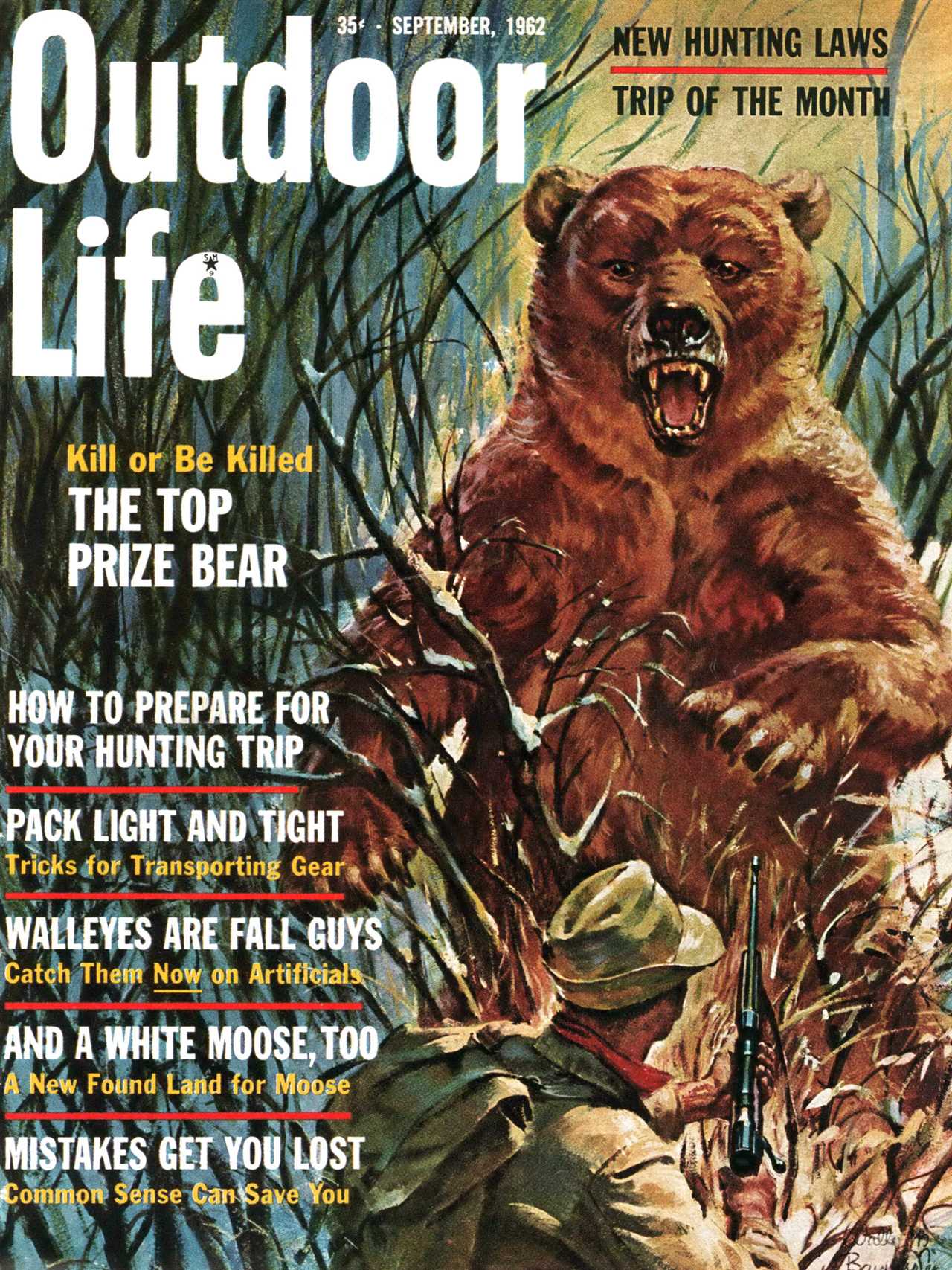Lever-actions make fine deer rifles, too. Outdoor Life
This article by former shooting editor Jack O’Connor, originally titled “Deer and Deer Rifles,” first appeared in the September 1962 issue of Outdoor Life. It was later reprinted as a chapter in his classic book The Hunting Rifle.
THE SCENE was the Arizona desert and the time was about two generations ago. One of the actors was a skinny, long-legged kid, a clumsy lout with big feet, green eyes, light hair, and a hide so browned by the sun that on the rare occasions when he wore a hat and his straw-colored hair could not be seen he was often taken for a light-eyed Mexican.
The other was an equally skinny, three-year-old buck mule deer, slabsided and probably beset with worms. The kid called the buck a blacktail because in those days everyone in Arizona called mule deer blacktails. The buck was not very well nourished but it had a spindly four-point head, which in the East would be considered a 10-pointer.
Anyway, when he was hunting quail, the kid had found an area all tracked up by desert mule deer. In addition, he had actually seen a doe and a fawn. In those lawless days, the sight of a deer was rare on the Arizona desert since the animals were hunted in season and out.

O’Connor with a desert buck, photographed in the early 1940s. Outdoor Life
So, saying nothing to anyone about his plans, the kid had gone out the next day with a rifle instead of a shotgun. It was a .30/40 Krag with a 30-in. barrel. The kid had paid $1.50 for it. He had bought it from a bindle stiff (tramp) who had been camped down by the river beneath a wrecked railroad bridge. The bindle stiff had found himself in great need of a bottle of corn squeezings and in no particular need of a rifle just then. His asking price for the Krag was $3, and the lowest price he would accept was $1.50. By a curious coincidence, the price of a bottle of popskull was $1.50, and the kid happened to have that much scratch with him.
So the bindle stiff got his jug and the kid got his rifle. Ammunition, as he now remembers it, cost about $1.25 a box. The cartridges were loaded with the long 220-gr. bullet with a lot of lead exposed. The bindle stiff had evidently known a thing or two about a rifle, as he had put on a homemade front sight that lined up with the military rear sight so that the old musket shot at point of aim at about 150 yd.
So, that frosty winter morning the kid was sneaking cautiously through that tracked-up desert forest looking for a deer. Generally he couldn’t see over 100 yd. since this was a country of paloverde and ironwood trees, saguaros ( giant cactus), and cholla ( jumping cactus) . Then the kid became conscious of a movement on the other side of an ironwood tree about 50 yd. away. He suspected it was a deer, and the shock was so violent that afterward he had a headache.
Next he knew it was a deer, as the animal moved a bit and he could make out gray hide and dingy white rump; then he saw the deer’s head as the animal reached up and delicately nipped off a delectable bit of browse.
After what seemed like an hour but was probably less than a minute, the buck was fairly well out in the open. The kid could see the gray-shiny antlers. It was time to shoot. Shaking, he lifted his rifle and tried to keep the homemade front bead in the middle of the deer.
He was trembling so violently that the front sight jerked off and on the buck. He tried to remember to squeeze the trigger. He tried to make himself quit shaking. He hated himself because he could not. He was desperately afraid the buck would see him and take off.

Then-shooting editor Jack O’Connor with what he considered a good deer rig: a .308 Winchester Model 100 topped with a “Leupold variable-power scope.” Outdoor Life
Finally he yanked the trigger. The buck was gone, and the kid stood there, his heart pounding, his head aching, his hands still trembling, his legs weak. After the roar of the shot, the desert seemed deathly still. He heard a quail call, and far off in the quiet desert air the sweet and melancholy whistle of a freight train. He had blown his chance and he’d probably never get another.
Slowly he walked over toward the spot where the deer had been. There were the tracks all right; he could see how they had plunged through the soft, sandy soil as the deer had run. Desperately he tried to think of an alibi. It was that damned, long-barreled rifle, he decided. What he’d wanted was a real deer rifle, a .30/30 Winchester or Marlin carbine. But those cost $15 down at the hardware store, and as far as he was concerned they might as well have cost $1,000.
Hopelessly he followed the tracks. He had gone about 50 yd. when he got another violent shock. He saw blood. He could hardly believe it. At first there were a few drops. Then he found a big splash, then more. He followed the blood. Then he saw something gray and quiet beside a bush ahead of him. It was the buck-and the buck was dead. The old 220-gr. soft point had struck just forward of the flank and had come out behind the left shoulder.
Maybe the fact that that old Krag happened to wobble on just as the kid yanked the trigger had a lot to do with making him a hunter. Anyway, the kid grew up, became a father and a grandfather, and almost every year of his life he has hunted deer-whitetails and mule deer, big deer and little deer, deer in brush and deer in open country, deer on the flats and deer in mountains almost rugged enough for sheep, deer far north in Alberta and British Columbia and deer south in tropical Sinaloa.
He has hunted deer with that old .30/40, with a .256 Newton, a .250/3000 Savage, a .30/30, a 7 mm. Mauser, several .30/06 and .270 rifles, a .35 Remington, a .257, a .348, a .35 Whelen, a .300 Weatherby. He has killed deer with a .22 Hornet, a wildcat 2-R Lovell, and a .22 rimfire.
How many deer this chap has shot he does not remember, but it has been quite a few. He has done a little deer hunting in Pennsylvania and South Carolina and quite a bit of it in Texas, but most of the deer he has shot have been mule deer (of the desert and Rocky Mountain variety) and Arizona whitetails. He has heard of mule deer that have dressed out at 400 lb. and more, but he doesn’t believe such an animal exists. The heaviest buck he ever weighed field dressed was, as he remembers it, 235 lb., but he has shot two bucks that weighed about 175 in the quarters, and he thinks they might have gone 250 field dressed. The heaviest Arizona whitetail he ever shot weighed 118. He once shot a whitetail buck with 19 points in all and has shot several mule deer with 13 and 14 points altogether. He once killed two deer with one shot and once helped a couple of companions put 14 shots into a 110-lb. buck before it went down. The antlers with the widest spread he ever shot went 37 in., but he has seen mule deer heads that went from 45 to 48 in.

Old-time favorite medicine for whitetails was (from left): .25/35, .30 Remington, .30/30, the .32 Special, .303 Savage, .35 Remington, and the .348 Winchester. Outdoor Life
This hunter has missed more deer in the brush than anyplace else. The best shot he ever made on a deer was with a scope-sighted .30/06 at 330 paces. He could see only the buck’s head and neck, took a rest over a log, held what looked like about 9 inches over the top of the neck, and broke it. His worst shot was a clean miss-before two witnesses—at a standing buck broadside at not over 125 yd. He was afraid the deer was about to jump, and he yanked the trigger.
A good deal of deer hunting has convinced this chap that deer are easy to kill if the bullets hit in the right place and behave properly. He also knows that if the bullets don’t hit in the right place deer are very hard to kill.
ALMOST ALWAYS this deer hunter, if he has the opportunity, tries to place the bullet through the lungs back of the foreleg. If the deer it not broadside, he aims to drive the bullet up into this area. He likes the lung shot because it is a large target easy to hit, and because if a bullet placed there behaves properly, the deer seldom goes far and is generally dead within a few yards of where he is hit. Furthermore, the bullet that goes through the buck’s rib cage from side to side destroys no edible meat.
This hunter thinks there are two very different kinds of deer rifles—one to be used in brush and forest and the other to be used in hilly, open country. For the kind of brush and forest hunting done for whitetail deer in the East, for blacktails west of the Coast Range in northern California, Oregon, and Washington, for mule deer early in the season in thick spruce and fir at high altitude, and for mule deer in the brushier parts of the Sonora desert he likes a light, fast-operating rifle with a short barrel. He thinks such a weapon should be chambered for a reasonably heavy bullet at moderate velocity.
“A good deal of deer hunting has convinced this chap that deer are easy to kill if the bullets hit in the right place and behave properly. He also knows that if the bullets don’t hit in the right place deer are very hard to kill.”
The reason for this is that the heavy, round-nose bullet that isn’t traveling at breakneck speed gets through brush with less deflection than faster, lighter bullets with sharp points. But he also knows that any bullet can be deflected by brush. He remembers one time when he took a shot at a moose through heavy brush at what he remembers as being about 30 yd.-and missed the whole moose. His next shot at the moose was in the clear and he killed it. He remembers also three shots at a whitetail buck that foolishly ran in a semicircle around him through heavy brush. The first two shots, he afterward found out, did no damage except to nick the buck with some fragments of bullet jacket, but on the third shot the buck went through an opening and the 180-gr. 30/06 bullet piled him up.
Unlike many hunters who look down their noses at the .30/30, he thinks it an excellent cartridge for this sort of thing. And he likewise regards the .32 Special as a good brush cartridge with adequate killing power-at moderate ranges and with well-placed shots-for any North American deer that ever walked. He also thinks that the light, fast-handling Winchester and Marlin lever actions in such calibers are about right for deer.
Because there is always a possibility that the first shot at a deer in brushy country may hit a limb or a twig and deflect, he thinks that for hunting of this sort a lever action, a pump, or a semiautomatic is a good idea for the woods hunter. All of these are faster than the bolt action. The Winchester Models 94 and 88, the Marlin Model 336, the Savage Model 99, the Remington Model 760 pump, and the Remington Model 7 42, the Ruger carbine, and the Winchester Model 100 are all light, handy, fast-operating weapons.

For brush hunting, O’Connor says a bolt-action isn’t the. best choice. Outdoor Life
This old deer hunter, as we have seen, has killed deer with a .22 rimfire. They were killed at a Mexican waterhole at very short range. He has likewise killed deer with carefully placed shots with varmint calibers like the .22 Hornet, the 2-R Lovell, and the .22/250. However, he has seen the high-speed .22 bullets go to pieces on large bones (if a deer can be said to have large bones) and even on ribs, and doesn’t think deer should be shot with any bullet weighing less than 90 gr. He thinks a minimum of 100 gr. is better.
For short-range woods shooting, he thinks any fairly heavy bullet that opens up quickly is adequate for deer. The old .44/40 cartridge with its 200-gr. bullet at a muzzle velocity of 1,310 ft. seconds has probably killed more whitetail deer than any other cartridge with the possible exception of the .30/30. The .44 Magnum revolver cartridge shot in the Ruger carbine should be deadly.
BUT IF HE were going in hock for a new brush rifle, he thinks he’d acquire a Marlin lever action or a Remington pump for the .35 Remington cartridge or a Model 88 Winchester or Model 99 Savage in .358.
He regards the neglected .358 Winchester cartridge with its 200-gr. bullet at 2,530 or its 250-gr. bullet at 2,250 as probably the most deadly woods cartridge in existence—not only for deer but for elk and even moose. The .358 has the power and weight to drive deep on the rear-end shots which the woods hunter all too often has to take.
Over the years this deer hunter has had more trouble with bullets that didn’t open up fast enough than he has had with bullets that penetrated too deeply. He thinks that if the deer hunter has a choice he should take the fast-opening bullet.
For woods shooting he hasn’t got much use for open sights. Under the stress of excitement, it is easy to shoot over with them since the tendency is not to get the bead down into the notch. Receiver sights are better, but the best iron sights were the peeps close to the eye-the old Lyman tang and cocking-piece sights. They were not the most accurate sights in the world, but they were adequately accurate for 50-100 yd. shooting.
The best sight he has ever used in the brush is a low-power scope (2½ or 3X) because of the wide field of view and because of the ability of the glass sight to resolve detail, to “look through” the brush, to tell deer from limbs and twigs.
For open-country deer hunting at longer ranges, this chap likes a flat-shooting cartridge giving a fairly light bullet a velocity of from 2.700 to 3 200 ft. seconds. Then he likes to sight in for the longest range that will not give him midrange misses. The world is full of good, open-country deer cartridges—the .30/06 with the 150-gr. bullet, the .270 with the 130-gr., the .280 with the 125-gr., the 7 mm. Remington Magnum with the 150-gr., the 7 x 57 Mauser with the 140-gr., the .300 Savage and the .308 with the 150-gr. He has never shot a deer with the .243 but considers it entirely adequate with the 100-gr. bullet. He bases this opinion on a good deal of use of the now-dying .257 Roberts on deer.
However, he has done more open-country shooting of mule and whitetail deer with .30/06 and .270 rifles than with anything else. The quickest-killing .30/06 bullet he ever used was the old 150-gr. Western hollow point. Bullets he liked for the .270 were the Remington 130-gr. Bronze Point, the 130-gr. Speer and Sierra, the Western Silvertip, the 120-gr. Barnes. Some of the controlled expanding bullets don’t open up quite fast enough, he thinks, and don’t give kills quite so quick. He remembers a buck he shot with his rifle rested over a rock at about 325 yd. Dust could be seen to fly above the deer’s back as it stood on a hillside. “Over,” his companion said. But before he could shoot again, the buck was down. If the bullet had opened faster the deer would have collapsed in its tracks.
For this open-country shooting at deer, this hunter now uses 4X scopes. They have sufficient field and they give a better picture of the deer and more precise aim. However, this hunter admits that probably a 2½ or 3X scope will do just about as well for any big game, even at ranges of 300 yd. and over. Before World War II, he used 2óX scopes almost exclusively and never felt himself underpowered. Flat-shooting, high-velocity, bolt-action rifles, such as those described, are also excellent for those Eastern hunters who shoot from hillside to hillside at deer when the leaves are off the trees and bushes and for those who plan to shoot across pastures at deer coming out of the woods to feed.

This shooting column originally ran in the September 1962 issue. Outdoor Life
But they are by no means ideal for ordinary woods hunting. The fast bullets deflect badly in the brush, this deer hunter thinks. In addition, the 4X scopes are a bit shy of field for brush hunting, and the bolt action is on the slow side for the fast second shot.
LIKEWISE, most of the brush cartridges are not much good for open-country shooting where shots will often be taken at 300-350 yd. Used as it should be, the ,30/30 is a good killer on deer. Shot wildly at deer 250-350 yd. away, it isn’t so .hot. When this chap got out of college his pocketbook was thin and he had sold his rifles so he would have enough jack in his jeans to take pretty girls dancing. He ordered the then brand-new Model 54 Winchester rifle in .270 caliber, but until it came he tried to make do with an ancient Model 8 Remington automatic for the .35 Remington cartridge. He hunted in semiopen country of juniper, piñon and yellow pine, and the shots he got were long. It was a pretty frustrating experience.
But cartridges like the .308, the .300 Savage, and the .30/06 when used with suitable, round-nose 180-gr. bullets do pretty well for the brush as well as for open country. The .270 and .280 with the round-nose 150-gr. bullets are usable in the brush and shoot flat enough for much open-country shooting. Once this chap hunted in the jungles of India, shot everything including hog deer, spotted axis deer, wild boar, and even peacocks with the 150-gr. Core-Lokt and Hornady round-nose soft-point .270 bullets. He didn’t have much to complain of.
The old deer hunter in this little piece is, of course, your correspondent. The piece is directed mostly to the many thousands of Outdoor Life readers who have done little or no deer hunting but who will be out for deer this fall. The old deer hunter wishes them well and hopes they get a good bullet in the right spot. If they do, they’ll find that almost any reasonably potent rifle will get them venison.
Read more OL+ stories here.
The post Jack O’Connor’s Final Word on How to Pick a Deer Rifle appeared first on Outdoor Life.
By: Jack O’Connor
Title: Jack O’Connor’s Final Word on How to Pick a Deer Rifle
Sourced From: www.outdoorlife.com/guns/jack-o-connor-choosing-deer-rifles/
Published Date: Tue, 06 Dec 2022 15:12:03 +0000
----------------------------------------------
 Backyard GrillingWeekend WarriorsAdvice from DadBeard GroomingTV Shows for Guys4x4 Off-Road CarsMens FashionSports NewsAncient Archeology World NewsPrivacy PolicyTerms And Conditions
Backyard GrillingWeekend WarriorsAdvice from DadBeard GroomingTV Shows for Guys4x4 Off-Road CarsMens FashionSports NewsAncient Archeology World NewsPrivacy PolicyTerms And Conditions
